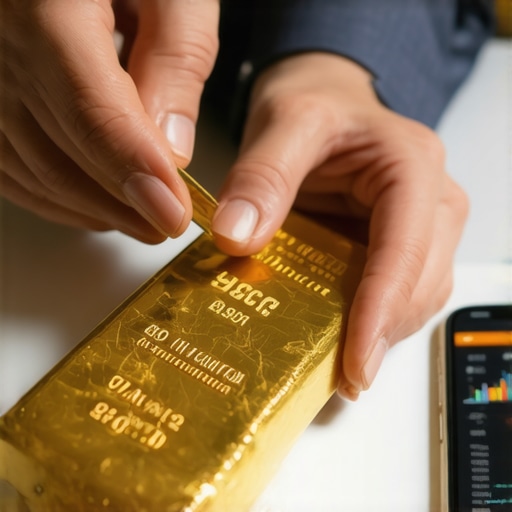Unlocking the Golden Opportunity: Why Consider a Gold IRA Account?
For investors seeking to diversify their retirement portfolios beyond traditional stocks and bonds, a Gold Individual Retirement Account (IRA) offers a compelling alternative. This specialized IRA allows you to hold physical gold or other precious metals as part of your retirement savings, providing a hedge against inflation, currency fluctuations, and market volatility. The allure of gold lies in its enduring value, often shining brightest during economic uncertainty or geopolitical unrest.
Imagine Jane, a 45-year-old professional, concerned about the unpredictability of the stock market. By allocating a portion of her IRA to gold, she not only preserves her wealth but also gains peace of mind through tangible asset ownership. This real-world scenario embodies the practical advantage of incorporating gold into retirement strategies.
Decoding the Mechanics: How Does a Gold IRA Work?
A Gold IRA functions similarly to a traditional IRA but distinguishes itself by allowing investment in IRS-approved precious metals, such as gold, silver, platinum, and palladium. Contributions can be made via transfers or rollovers from existing retirement accounts. The assets are held by a custodian who manages the account and ensures compliance with IRS regulations.
Unlike conventional IRAs that invest in financial instruments, Gold IRAs require physical storage in an approved depository. This adds an extra layer of security but also involves specific rules and fees. Understanding these operational nuances is essential to fully harness the benefits of gold within your retirement plan.
Strategic Insights: What Are the Advantages and Risks of Gold IRAs?
Gold IRAs offer unique benefits including diversification, inflation protection, and potential tax advantages. Gold historically maintains purchasing power even when fiat currencies weaken, making it a strategic shield against economic downturns.
However, investors must also weigh risks such as storage costs, liquidity constraints, and market price volatility. Unlike stocks, gold does not yield dividends or interest, which may affect long-term growth. A nuanced approach involves balancing gold investments with other asset classes to optimize portfolio resilience.
What Should Beginners Know Before Investing in a Gold IRA?
For those new to precious metals IRAs, it’s vital to select a reputable custodian experienced in managing these accounts. Fees can vary widely, including setup, storage, and administrative charges. Additionally, investors should verify that the gold meets the purity standards mandated by the IRS (typically 99.5% purity for gold bullion). Educating yourself on these criteria will prevent costly mistakes.
Furthermore, understanding the tax implications—such as required minimum distributions and potential penalties—is critical for long-term planning. For deeper insights, the IRS official guidelines on IRAs provide authoritative information on compliance and regulations.
Expert Tips for Maximizing Gold IRA Benefits
To truly unlock the potential of a Gold IRA, consider integrating it with complementary investment strategies. For example, pairing physical gold holdings with gold ETFs or mining stocks can enhance liquidity and growth potential. This diversified approach aligns with expert recommendations for hedging against inflation and market risks, as detailed in our guide to gold investment strategies.
Moreover, maintaining awareness of global gold demand trends and market price forecasts can inform timely decisions, ensuring your retirement portfolio remains resilient in evolving financial landscapes.
Ready to deepen your understanding of gold investments? Share your thoughts or questions below, and explore more expert resources to build a secure retirement future.
Optimizing Your Gold IRA: Advanced Strategies for Savvy Investors
While integrating gold into your retirement portfolio offers fundamental benefits, seasoned investors often leverage advanced strategies to maximize returns and minimize risks. One such approach involves rebalancing your Gold IRA periodically to reflect shifting market dynamics and economic indicators. For example, during periods of rising inflation or geopolitical tension, increasing gold allocation can enhance portfolio stability, while reducing exposure in bullish equity markets may preserve growth potential.
Another sophisticated tactic includes blending physical gold holdings with gold-focused exchange-traded funds (ETFs) and mining stocks. This hybrid model combines the tangible security of bullion with the liquidity and growth prospects of market-traded assets. As detailed in our analysis of gold ETFs versus stocks for portfolio stability, such diversification can help balance volatility without sacrificing the inflation-hedging qualities of gold.
Global Gold Demand and Its Impact on Your Gold IRA
Understanding macroeconomic factors influencing global gold demand is crucial for informed Gold IRA management. Central banks around the world have been net buyers of gold, aiming to diversify reserves away from traditional fiat currencies. This trend bolsters price support and signals long-term value retention. Meanwhile, emerging market consumers drive physical demand through jewelry and investment purchases, particularly in Asia.
Economic uncertainties, such as fluctuating currency values and geopolitical risks, further amplify gold’s safe-haven appeal. Investors with Gold IRAs should monitor these demand drivers closely, as they often precede significant price movements. Our comprehensive guide on gold demand trends offers detailed insights into these global market forces.
How Can Investors Effectively Balance Gold’s Role Amid Market Volatility?
Balancing gold’s unique characteristics within a broader portfolio requires a nuanced understanding of both its advantages and limitations. Since gold does not generate income, its primary value lies in capital preservation and risk mitigation. Experts often recommend allocating between 5% to 15% of a retirement portfolio to gold, depending on individual risk tolerance and economic outlook.
Strategically timing contributions and rebalancing can capitalize on gold’s countercyclical behavior. For instance, during equity market downturns, increasing gold exposure may offset losses, while trimming allocations in bull markets preserves capital for growth opportunities. Utilizing tools such as gold futures can also provide tactical flexibility for experienced investors aiming for short to medium-term gains.
For a deeper dive into these balancing techniques, consider exploring our expert guide to mastering gold trading techniques.
According to the World Gold Council, gold demand in 2023 was influenced heavily by central bank purchases and investor interest amid persistent inflation concerns, underscoring its critical role in diversified portfolios (World Gold Council, 2023). This authoritative data emphasizes why incorporating gold thoughtfully within IRAs can protect retirement wealth against unpredictable financial environments.
What are your experiences or strategies with Gold IRAs? Share your insights or questions in the comments below, and don’t forget to explore our extensive resources on choosing the best gold investment types to enhance your retirement planning.
Mastering Custodial Selection: Ensuring Security and Compliance in Your Gold IRA
One of the pivotal decisions an experienced investor faces when managing a Gold IRA is choosing the right custodian. Unlike traditional IRAs, Gold IRAs require custodians who specialize in the nuances of precious metals regulations and storage logistics. The custodian not only holds the precious metals but also ensures adherence to IRS mandates, including purity requirements and approved depository usage.
Industry veterans recommend conducting thorough due diligence by examining custodial fee structures, transparency of operations, and reputation within the precious metals community. Additionally, custodians with robust insurance policies for physical assets and cutting-edge security measures provide an added layer of confidence. An often-overlooked aspect is the custodian’s proficiency in facilitating smooth rollovers and transfers, which can significantly impact tax efficiency and liquidity.
How Do Custodial Choices Affect Gold IRA Performance and Investor Protection?
Custodial selection directly influences both the operational efficiency and risk profile of your Gold IRA. For instance, some custodians may charge exorbitant storage or administrative fees that erode long-term returns. Furthermore, custodians vary in their network of IRS-approved depositories; partnering with those offering geographically diverse and highly secure vaults mitigates geopolitical and physical risks.
Investor protection is also enhanced by custodians who maintain regular audits and provide transparent reporting. This fosters trust and enables proactive portfolio management. As highlighted by the Investopedia Gold IRA Custodian Guide, understanding these custodial dynamics is essential for safeguarding your retirement assets.
Advanced Risk Mitigation Techniques: Hedging Gold IRA Exposure Amid Economic Uncertainty
Beyond custodial considerations, sophisticated investors employ layered risk mitigation strategies to protect their Gold IRA portfolios. One such approach involves the use of precious metals derivatives, including gold futures and options, which can provide tactical hedges against short-term price fluctuations. While these instruments introduce complexity, they offer flexibility to capitalize on market volatility without liquidating physical holdings.
Another advanced strategy is geographic and asset diversification within the precious metals space. Allocating portions of your Gold IRA to silver, platinum, or palladium can reduce exposure to gold-specific market risks, particularly when demand or supply dynamics shift. Furthermore, incorporating mining equities and royalty trusts can offer asymmetric growth opportunities while maintaining precious metals exposure.
Investors must also consider the macroeconomic context. For example, rising real interest rates often pressure gold prices downward, necessitating dynamic portfolio adjustments. Utilizing economic indicators such as the Consumer Price Index (CPI), Federal Reserve policy signals, and geopolitical risk indices can guide timing and allocation decisions, optimizing risk-reward balance.
Integrating Tax-Efficient Withdrawal Strategies in Gold IRA Management
Tax implications in Gold IRAs are intricate and require careful planning. Withdrawals are generally subject to ordinary income tax rates, and required minimum distributions (RMDs) apply starting at age 73. However, because physical gold must remain in IRS-approved storage, liquidating assets to meet RMDs can be challenging.
Proactive investors consider phased liquidation strategies, potentially selling gold ETFs or mining stocks held in conjunction with physical bullion to satisfy RMD requirements without disrupting bullion holdings. Moreover, Roth Gold IRAs, which involve after-tax contributions, allow for tax-free qualified withdrawals, representing an attractive option for those anticipating higher future tax brackets.
Consulting with tax professionals experienced in precious metals IRAs ensures alignment of withdrawal plans with evolving tax legislation and personal retirement goals.
Ready to elevate your Gold IRA strategy with expert custodial insights and risk management techniques? Dive deeper into our advanced resources or connect with a certified precious metals advisor to tailor a portfolio that withstands the complexities of modern financial markets.

Custodian Selection: Navigating the Nuances for Enhanced Gold IRA Security
In the realm of Gold IRAs, the custodian’s role transcends mere storage—it is a linchpin in safeguarding assets while ensuring rigorous compliance with IRS mandates. Advanced investors recognize that custodial expertise must encompass not only secure vaulting but also adept handling of regulatory complexities, such as verifying bullion purity and facilitating seamless rollovers. Evaluating custodians based on their operational transparency, insurance coverage, and custody network diversity is paramount to mitigating geopolitical and logistical risks.
How Can Advanced Custodial Practices Optimize Gold IRA Performance and Security?
Custodial efficacy directly impacts both the protection and growth potential of precious metals portfolios. For instance, custodians that leverage geographically dispersed, IRS-approved depositories reduce vulnerability to localized disruptions. Additionally, transparent fee structures and proactive audit routines ensure that investors avoid hidden costs and maintain trust in asset stewardship. As Investopedia emphasizes in its Gold IRA Custodian Guide, selecting a custodian with comprehensive insurance and a proven track record is critical for preserving retirement wealth.
Innovative Risk Management: Layered Hedging Strategies for Gold IRAs
Seasoned investors augment physical gold holdings by integrating derivatives such as futures and options, enabling tactical responses to market volatility without liquidating bullion. This layered approach allows for capitalizing on short-term price movements while maintaining core asset stability. Moreover, diversifying into complementary metals like silver, platinum, and palladium within the IRA can attenuate asset-specific risks and exploit varying demand cycles, enhancing overall portfolio resilience.
Monitoring macroeconomic indicators—ranging from Federal Reserve policy shifts to geopolitical tensions—enables dynamic allocation adjustments, optimizing the risk-reward profile. For instance, rising real interest rates often depress gold prices, signaling a potential reallocation toward mining equities or ETFs that may offer growth amid tightening monetary conditions.
Tax-Efficient Withdrawal Techniques: Navigating Complexities for Optimal Retirement Outcomes
Withdrawal strategies in Gold IRAs must reconcile IRS distribution mandates with the logistical challenges of liquidating physical assets. Employing phased liquidation—prioritizing more liquid holdings like gold ETFs or mining stocks for required minimum distributions—can prevent forced sales of bullion under unfavorable market conditions. Furthermore, Roth Gold IRAs present a compelling alternative by enabling tax-free qualified withdrawals, particularly beneficial for investors anticipating elevated tax brackets in retirement.
Engagement with tax professionals versed in precious metals IRAs is indispensable to align withdrawal timing and methods with evolving tax codes and individual financial goals, ensuring both compliance and maximized after-tax returns.
Ready to refine your Gold IRA approach with cutting-edge custodial insights, risk mitigation tactics, and tax strategies? Explore our advanced resources or connect with a certified precious metals advisor to architect a retirement portfolio resilient against today’s complex financial landscape.

Frequently Asked Questions (FAQ)
What exactly is a Gold IRA and how does it differ from a traditional IRA?
A Gold IRA is a self-directed Individual Retirement Account that allows investors to hold physical precious metals, primarily gold, instead of conventional financial assets like stocks or bonds. Unlike traditional IRAs, which invest in paper assets, Gold IRAs require storage of IRS-approved bullion in secure depositories, adding complexity but offering tangible asset diversification and inflation protection.
What types of gold and precious metals are IRS-approved for a Gold IRA?
The IRS mandates that gold must be at least 99.5% pure to qualify for Gold IRAs. Besides gold bullion coins and bars, approved metals include certain silver, platinum, and palladium products meeting specific purity standards. Ensuring your metals comply with these criteria is essential to maintain the tax advantages of the IRA.
How do the fees associated with a Gold IRA compare to traditional IRAs?
Gold IRAs typically involve additional fees such as setup charges, annual custodial fees, storage costs for the physical metals, and sometimes transaction fees. These can be higher than traditional IRAs due to the physical nature and regulatory requirements. It’s critical to evaluate custodial fee structures and storage options to optimize overall cost efficiency.
Can I rollover or transfer funds from my existing IRA or 401(k) into a Gold IRA?
Yes, funds from existing IRAs or 401(k) plans can be rolled over or transferred into a Gold IRA without tax penalties if done correctly. The process involves choosing a qualified custodian and ensuring compliance with IRS rollover rules. Proper execution preserves the tax-deferred or tax-exempt status of your retirement funds.
What are the liquidity considerations when investing in physical gold within an IRA?
Physical gold held in a Gold IRA is less liquid compared to stocks or ETFs, as selling bullion requires coordination with custodians and depositories, which may take time and incur fees. Investors often supplement physical holdings with gold ETFs or mining stocks to maintain liquidity while benefiting from gold exposure.
How can I manage required minimum distributions (RMDs) from a Gold IRA?
Since physical gold cannot be easily divided or liquidated, many investors use a combination of liquid assets such as gold ETFs or mining stocks within the IRA to satisfy RMDs. Alternatively, phased liquidation of physical bullion is planned to comply with IRS distribution mandates starting at age 73, minimizing tax impacts and market risk.
What strategies can I employ to balance gold exposure amid fluctuating market conditions?
Experts recommend allocating 5% to 15% of your retirement portfolio to gold, adjusting allocations in response to inflation, interest rates, and geopolitical events. Combining physical gold with ETFs and mining stocks provides diversification. Periodic portfolio rebalancing based on economic indicators helps optimize risk and returns.
Are Roth Gold IRAs available and what benefits do they offer?
Yes, Roth Gold IRAs allow after-tax contributions with the advantage of tax-free qualified withdrawals in retirement. This can be especially beneficial if you anticipate higher tax brackets in the future. Roth Gold IRAs follow the same custodial and storage rules as traditional Gold IRAs but differ in tax treatment.
How do I choose a trustworthy custodian for my Gold IRA?
Selecting a custodian with strong security protocols, transparent fee structures, IRS-approved depository partnerships, and comprehensive insurance coverage is vital. Due diligence includes reviewing customer feedback, audit history, and custodial expertise in precious metals to safeguard your investment efficiently.
What tax implications should I be aware of when investing in a Gold IRA?
Contributions to traditional Gold IRAs are tax-deferred, while withdrawals are taxed as ordinary income. Roth Gold IRAs provide tax-free withdrawals. Additionally, penalties may apply for early distributions before age 59½. Consulting tax professionals familiar with precious metals IRAs ensures compliance and maximizes tax efficiency.
Trusted External Sources
- IRS Official Website – Retirement Plans and IRAs: Provides authoritative regulations and guidelines on IRA eligibility, contribution limits, and compliance specific to precious metals IRAs, ensuring investors adhere to legal standards.
- World Gold Council: An industry-leading organization offering comprehensive research on global gold demand, market trends, and investment strategies, critical for understanding macroeconomic drivers influencing Gold IRA valuations.
- Investopedia – Gold IRA Custodian Guide: Delivers expert analysis on custodian selection, fee structures, and operational nuances, helping investors navigate the complexities of Gold IRA management effectively.
- U.S. Securities and Exchange Commission (SEC): Offers regulatory insights about investment risks and protections related to precious metals ETFs and mining stocks, complementing physical gold holdings within IRAs.
- National Association of Personal Financial Advisors (NAPFA): Provides access to certified financial planners experienced in retirement planning and precious metals, valuable for tailored Gold IRA strategies and tax planning.
Conclusion: Synthesizing Expert Insights on Gold IRAs for Secure Retirement Planning
Integrating a Gold IRA into your retirement portfolio offers a strategic avenue for diversification, inflation protection, and wealth preservation through tangible assets. Understanding the intricate mechanics—from IRS purity standards and custodial responsibilities to advanced risk mitigation and tax-efficient withdrawal strategies—is essential for maximizing benefits and minimizing pitfalls.
Expert approaches emphasize a balanced allocation, combining physical bullion with liquid instruments like ETFs and mining equities, complemented by vigilant portfolio rebalancing aligned with macroeconomic signals. Custodial selection emerges as a cornerstone for safeguarding assets, ensuring compliance, and optimizing costs.
Informed investors who harness these sophisticated strategies can build resilient retirement portfolios that weather market uncertainties while capitalizing on gold’s enduring value. We invite you to share your experiences or questions, explore our additional expert resources, and embark on a thoughtful journey toward securing your financial future with confidence in Gold IRAs.









